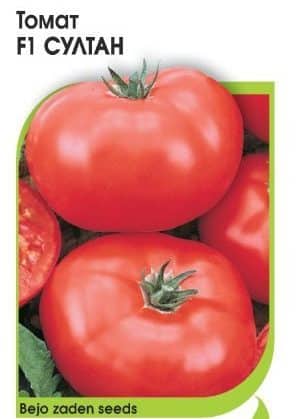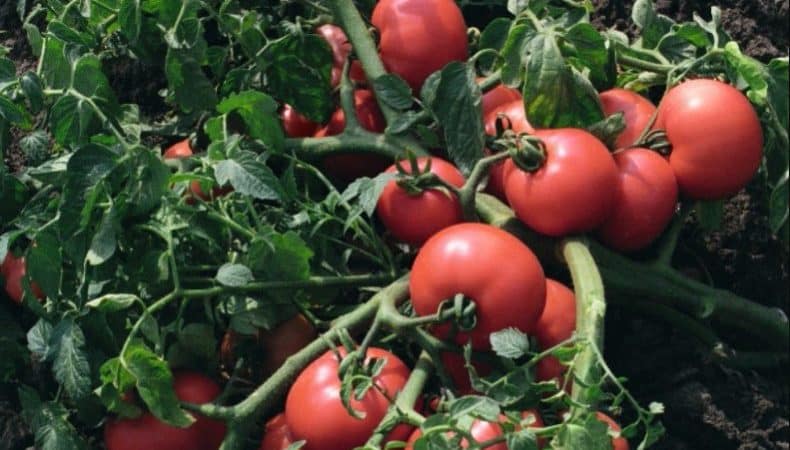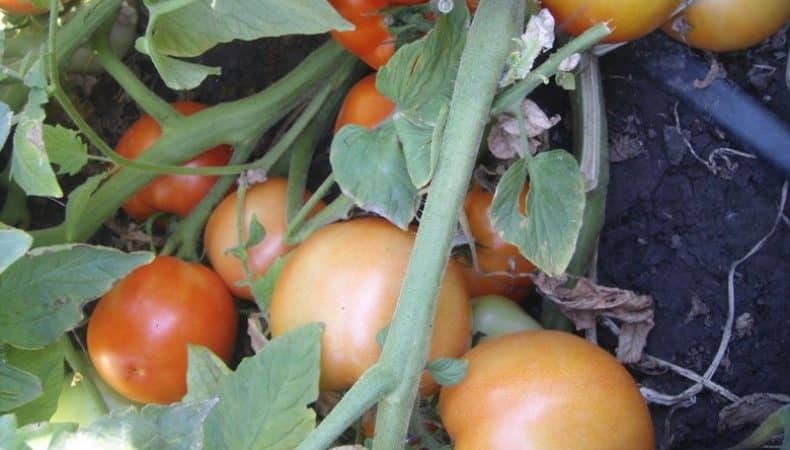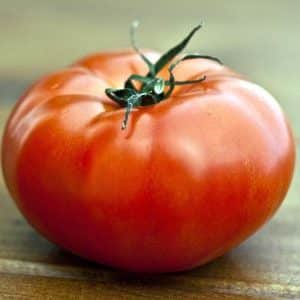A welcome guest on your site is the Sultan tomato: we grow it without hassle and enjoy the harvest
Tomatoes are an integral part of the modern human diet. They are included in many first and second courses; they are consumed fresh and processed. Most gardeners grow them on their plots.
Tomatoes with long fruiting are the most popular. They provide the gardener with a harvest from mid-summer until the first frost. Such tomato varieties must be selected with special care. It is at the end of summer that epidemics of plant diseases most often occur. The Sultan tomato is famous for its high immunity. This hybrid is not only resistant to late blight and other infections, but also has a bright, rich taste.
general description
Tomato Sultan is the development of Dutch breeders. The designation f1 indicates that this is a first generation hybrid, which means that its seeds from its fruits are not suitable for cultivation.
The patent for this hybrid belongs to Bejo Zaden. In our country it is produced by such manufacturers as “Prestige”, “Gavrish” and “Plasma Seeds”.
In 2000, Sultan was included in the Russian register. It is recommended for cultivation in the central and southern regions.
Features of the Sultan

Tomato Sultan is a hybrid that is easy to care for. Its compact bushes reach a height of only 50-60 cm. It does not require pinching, which reduces labor costs when growing it.
The fruits are ordinary, red, medium in size.Aligned as in the photo. They have a rich tomato taste with a slightly pronounced sourness, which is not typical for all hybrids. The pulp is dense, tender and juicy.
An important feature of Sultan for gardeners is the duration of fruiting. The first fruits ripen by mid-July, the last ones are removed from the bush in the second half of September.
Immunity is high. The hybrid is not afraid of fungal diseases, tobacco mosaic, and fusarium wilt. Rarely gets sick late blight.
Main characteristics
The Sultan tomato combines the positive characteristics of red-fruited varieties and hybrids. To collect delicious tomato berries all summer long, the gardener does not have to put in too much effort:
| Parameter | Indicators |
| Bush type | Determinant (stops growing on its own). Not standard. The bushes do not exceed 60 cm in height. The stems are powerful and durable. The amount of foliage is moderate. The leaves are simple, small in size, dark green in color, without pubescence. The first inflorescence is formed in the axil of 5-6 leaves, the next clusters are formed every 2-3 leaves. The fruits are formed in clusters of 5-7 pieces. Up to 6 racemes grow on one plant. |
| Growing method | In the southern regions it is cultivated in open ground. In the central and northern regions - mainly in greenhouses or under film covers. |
| Productivity | High. For the season from 1st quarter. m harvest about 17 kg of crop. |
| Fruit | Medium size. The weight of one berry varies between 100-200 g. The shape is round, flattened at the base. There is light ribbing at the base. Unripe berries are dark green. Ripe - bright red inside and outside without a green spot at the base. The skin is glossy, thin, but durable. The fruits have a large amount of dense but tender pulp. The taste is sweet with sourness.The dry matter content reaches 5%, and the sugar concentration averages 2.8%. One berry has from 6 to 8 chambers. |
| Transportability | High. They do not lose their shape during transportation and are stored for up to a month. |
| Ripening time | Mid-early. The first fruits ripen 100-110 days after sowing the seeds. Fruiting continues until the first frost. |
| Disease resistance | It is immune to most diseases characteristic of nightshade crops. |
Note! The Sultan's taste depends on his agricultural technology. The more sun the plants receive, the sweeter the fruits will be.
We grow seedlings
In our country, mid-early tomatoes are grown in seedlings. The time for sowing seeds depends on the climate of the region in which they are cultivated:
- southern - in early February;
- central - the beginning of March for a greenhouse and the end of March for open ground;
- northern - end of March for greenhouses.
The time for sowing seeds is calculated so that the seedlings are ready for transplanting to a permanent place in 55-60 days. Seedlings cannot be kept in pots. This will lead to a decrease in survival rate in new conditions.
Do the seeds need to be treated?
Most companies treat Dutch hybrid seeds in the factory. They are also covered with a shell containing all the necessary nutrients. Such planting material is sorted, checking for the presence of damaged and darkened seeds, and sown without pre-treatment.
If the instructions do not indicate information about seed treatment, then they are soaked in special solutions at home:
- In a glass of water with a teaspoon of salt added for half an hour. This procedure allows you to check planting material for germination.Floating seeds are considered unsuitable for planting.
- In a solution of potassium permanganate or hydrogen peroxide for 20 minutes. Such products disinfect planting material and reduce the risk of plant infection in the future.
- In "Epin", "Zircon" or "Sodium Humate". Treatment of seed material with growth stimulants is necessary to saturate it with nutrients. This accelerates seed germination and increases their viability.
Selection of containers and soil
To sow large quantities of seeds, use boxes or trays. Available materials will do, such as cut-off bottles, cake packaging, etc.
If you plan to plant only a few tomato bushes, then it is advisable to use peat tablets. It is possible to germinate seeds without soil; in this case, any container will do.
Plant seedlings into plastic or peat pots. A more economical option is disposable cups.
All containers are disinfected. They are poured with boiling water or a dark pink solution of potassium permanganate. The treatment should last at least 30 minutes.
You can buy soil for tomatoes in the store or prepare it yourself. A universal loose and nutritious mixture is suitable for tomatoes. It is made by mixing chernozem, humus and baking powder (sand, crushed coconut substrate, sawdust) in equal proportions.
The soil for tomatoes is also disinfected. It is calcined in the oven, poured with boiling water or a dark pink solution of potassium permanganate.
Sowing seeds in the ground and without soil
Soil is poured into the box so that 3 cm of unfilled soil remains to the edge. The soil is watered with warm water. Grooves 1 cm deep are made in it at a distance of 3 cm from each other.
Seeds are placed in the grooves at a distance of 2 cm. They are sprinkled with earth.Cover the containers with film and put them in a warm place.
Some gardeners practice growing seedlings without soil. In this case, the technology for sowing planting material will be different:
- It is convenient to use a one and a half liter bottle cut lengthwise as a container for germinating seeds.
- The bottom of the container is covered with several layers of napkins or toilet paper. It is moistened with warm water.
- Seeds are placed on paper. There should be a distance of 1-2 cm between them.
- The planting material is covered on top with several layers of paper, which are moistened with warm water from a spray bottle. Cover the containers with film and put them in a warm place. It is important to ensure that the paper does not dry out.
- When cotyledon leaves appear on the sprouted plants, they are picked into individual pots.
Caring for tomato seedlings
Proper care of seedlings determines whether the plants will take root after picking or not. To get healthy and viable tomatoes, you need to fulfill seven simple conditions:
- Watering. Water the tomatoes as the soil dries, always with settled water at room temperature. Liquid stagnation should not be allowed, as this will lead to the death of plants. It is important to ensure that water does not get on the leaves of the seedlings.
- Greenhouse. The plants need extreme humidity for the first week before the seeds germinate. This is provided by film or glass. Then the improvised greenhouse is dismantled.
- Light. Young tomatoes need 16 hours of daylight. If there is not enough natural light, this is compensated with the help of fluorescent lamps.
- Temperature. For seeds to germinate quickly, they need a temperature of 25-27°C.A week after the appearance of the first shoots, the plants are placed in rooms with temperatures of 17°C for 7 days. They are then grown at room temperature.
- Picking. The seedlings are planted in individual pots after the formation of 2-3 true leaves. A drainage layer is placed at the bottom of containers with a volume of at least 300 ml.
- Feeding. During the entire period of growing seedlings, they are fed 3 times. Use complex fertilizers containing phosphorus. This substance promotes the development of a strong root system.
- Hardening. 14 days before planting tomatoes in open ground, they begin to take them outside or onto the balcony. For the first time, their duration of stay in the fresh air should not exceed 30 minutes. Then the time is gradually increased to 16 hours.
Sultan's agricultural technology
Tomato Sultan in the southern regions is grown in open ground. In cities with cold climates - in greenhouses. In the central lane, both options are possible.
In the southern regions, tomatoes are planted in a permanent place at the beginning of May, in cities with a temperate climate - at the end of May. In the northern part of Russia, seedlings are planted in protected soil at the end of May.
Before planting in a permanent place, the seedlings are fed and watered. Moist soil makes it easier to remove plants.
Planting seedlings in a permanent place
Tomatoes are light-loving plants. The sunniest area of the garden is chosen for them. Beds that did not grow nightshade crops last year are suitable.
The selected place is dug up and cleared of plants. Humus or mullein is added to the soil. If the acidity of the soil is increased, dry lime is added to it. If the soil is too dense, use river sand.
In spring, the beds are leveled with a rake. In the process, they are cleared of weeds.The holes are dug in rows in a checkerboard pattern. For 1 sq. m plant up to six Sultan tomato bushes.
Ash or long-acting fertilizers are poured into the bottom of the holes. After planting the tomatoes, the plants are watered. For each of them take 1 liter of water. The next watering will be possible only after 10 days.
Plant care

Despite their short stature, plants need tie up. Otherwise they will break under the weight of the harvest. Tomatoes are attached to wooden supports or trellises. Synthetic thread is used for garter, as natural material will rot.
Pinch There is no need for such bushes. They form a small number of shoots, which provide the plant with high yield.
After the first flower cluster has formed, the leaves below it are removed. No more than 3 leaves are picked per week.
Water Tomatoes need warm, settled water as the soil dries. It is important to ensure that the liquid does not get on the above-ground part of the tomatoes.
After each watering and rainfall, the soil is loosened. During this process, weeds are removed.
Tomatoes are fed 3-4 times during the entire growing season. Alternate organic and mineral compositions. Before fertilizing, you need to water the plants abundantly so as not to burn their roots with fertilizers.
Twice a season, tomatoes are sprayed with foliar fertilizers. Use products containing boron.
Problems during cultivation
When growing tomatoes, gardeners sometimes face a number of problems. The list shows the reasons for some of them:
- A large amount of greenery is formed on the plants, and few ovaries. This suggests that tomatoes fattening. The reason is too fertile soil. Reduce the amount of fertilizing.
- Ugly fruits. The most common reasons are violation of watering conditions and temperature conditions, pests.
- Curled leaves. Sign of plant infection. Possible causes are excessive pinching and high humidity.
Diseases and pests
Tomato Sultan is resistant to most tomato diseases. However, he needs disease prevention:
- Disinfection. Not only seeds, containers and soil, but also garden tools are treated with disinfectant compounds.
- Compliance with the rules of watering and pinching. These procedures are carried out when the sun is inactive. It is important to monitor the humidity level and prevent water from entering the above-ground part of the plants.
- Preventive treatments. The bushes are sprayed with a solution of potassium permanganate or copper sulfate.
- Protection from harmful insects. Plants are sprayed with a soap solution or wormwood decoction.
- Preventive examinations. Held weekly. Damaged bushes are removed.

The nuances of cultivation in open and protected ground
When growing tomatoes in a greenhouse, you need to ventilate the premises every week to maintain optimal humidity levels and prevent diseases.
In the greenhouse, tomatoes are watered once a week. In open ground - 2 or 3.
After picking tomatoes in open ground, they are covered with film at night for the first two weeks. This measure is needed to protect the bushes from night frosts.
Harvesting and application
The Sultana harvest is harvested in the second half of July. The fruits are picked both on clusters and individually. They also ripen at home; in this case, the sweetness in the berries will be less.
The Sultana harvest is used for fresh consumption and canning as a whole. These tomatoes make delicious juices and sauces.
Advantages and disadvantages of a hybrid
Sultan's advantages:
- immunity to disease;
- high productivity;
- rich taste;
- versatility of use;
- seeds are often sold in processed form;
- no need for stepsoning;
- possibility of thickening plantings.
The disadvantages include the hybridity of the Sultan. Seeds from its fruits cannot be used for planting.
Farmer reviews
Reviews about Sultan are contradictory. Some gardeners believe that in our time there are varieties with higher quality fruits with similar characteristics.

Anna, Nikopol: “I have been growing Sultan for three years now. I plant directly in open ground. For a bed of 2 square meters. m fits 12 bushes. It turns out about 5 buckets of fruits with a pleasant sweet taste. Suitable for both preservation and fresh consumption. Requires minimal maintenance."
Igor, Zelenograd: “Last year I planted the Sultan tomato. In our region, its cultivation is possible only in a greenhouse. I didn’t like Sultan as a greenhouse hybrid. There are mid-early varieties with a more original taste. To be fair, I note that caring for him is really very simple. This year I’ll plant a couple of bushes in open ground and see what happens.”
Conclusion
Sultan tomatoes are a hybrid with good taste and high yield. It will not surprise experienced gardeners, but will delight beginners. Due to its high immunity to tomato diseases, short stature and lack of need for pinching, its cultivation requires minimal labor.